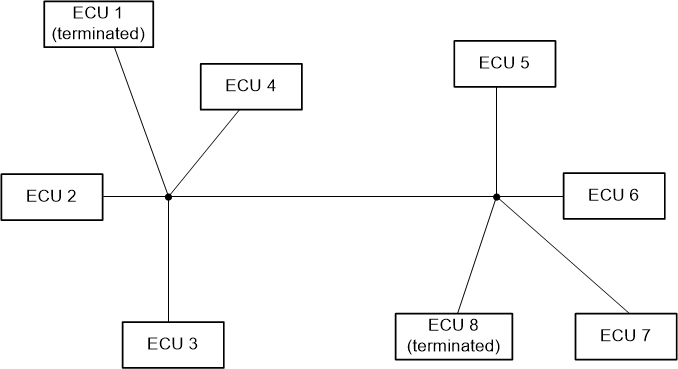SLLSFV9 July 2024 TCAN1473-Q1
ADVANCE INFORMATION
- 1
- 1 Features
- 2 Applications
- 3 Description
- 4 Pin Configuration and Functions
- 5 Specifications
- 6 Parameter Measurement Information
-
7 Detailed Description
- 7.1 Overview
- 7.2 Functional Block Diagram
- 7.3
Feature Description
- 7.3.1 Supply Pins
- 7.3.2 Digital Inputs and Outputs
- 7.3.3 GND
- 7.3.4 INH Pin
- 7.3.5 WAKE Pin
- 7.3.6 CAN Bus Pins
- 7.3.7
Faults
- 7.3.7.1 Internal and External Fault Indicators
- 7.3.8 Local Faults
- 7.4 Device Functional Modes
- 8 Application Information Disclaimer
- 9 Device and Documentation Support
- 10Revision History
- 11Mechanical, Packaging, and Orderable Information
7.1.1 Signal Improvement
The TCAN1473-Q1 includes the Signal Improvement Capability (SIC) that enhances the maximum data rate achievable in complex star topologies by minimizing signal ringing. Signal ringing is the result of reflections caused by impedance mismatch at various points in a complex CAN network.
An example of a star network is shown Figure 7-1.
 Figure 7-1 CAN network: Star Topology
Figure 7-1 CAN network: Star TopologyRecessive-to-dominant signal edge is usually clean as it’s strongly driven by the transmitter. Transmitter output impedance of CAN transceiver is RID(dom) and matches to the network characteristic impedance. For a regular CAN FD transceiver, dominant-to-recessive edge is when the driver output impedance goes to approximately 60kΩ and signal reflected back experiences impedance mismatch which causes ringing. The TCAN1473-Q1 resolves this issue by TX-based Signal improvement capability (SIC). The TCAN1473-Q1 continues to drive the bus recessive strongly for tSIC_TX_base to minimize the reflections, and the recessive bit is clean at the sampling point. In the active recessive phase, transmitter output impedance is low (RID(active_rec)). After this phase, the device enters into a passive recessive phase where the driver goes into high impedance state. This phenomenon is explained using Figure 7-2. For further information, please refer to the white paper on how SIC unlocks the real potential of CAN-FD transceivers.
 Figure 7-2 TX based Signal Improvement Capability
Figure 7-2 TX based Signal Improvement Capability